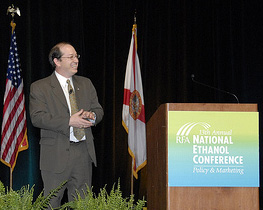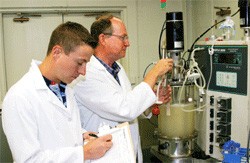The Missouri State Senate has passed a biodiesel standard that would require all diesel sold in the state to contain at least 5 percent biodiesel.
This story in the St. Louis Post Dispatch says if it passes the Missouri House and gains the governor’s signature (which he has indicated he will sign it), it will be the highest biodiesel requirement in the country:
“It gets biodiesel into the fuel distribution system,” said Sen. Bill Stouffer, the bill’s sponsor. “I’m not a mandate guy, but when the competition owns the system, the only way to get it into the system is to force it.”
 The move has gained the praise of the Missouri Soybean Association:
The move has gained the praise of the Missouri Soybean Association:
 “A B5 Standard is the next step in advancing Missouri’s growing biofuels industry and we are grateful for the leadership that Senator Stouffer has provided on this important issue,” said Dale R. Ludwig, Missouri Soybean Association (MSA) Executive Director/CEO. “It is refreshing to have people who realize the important role biodiesel can play in reducing our dependency on foreign oil. Missourians can take pride in knowing that homegrown, renewable fuels, such as biodiesel, keep more dollars in the state when we spend less on petroleum-based fuels.”
“A B5 Standard is the next step in advancing Missouri’s growing biofuels industry and we are grateful for the leadership that Senator Stouffer has provided on this important issue,” said Dale R. Ludwig, Missouri Soybean Association (MSA) Executive Director/CEO. “It is refreshing to have people who realize the important role biodiesel can play in reducing our dependency on foreign oil. Missourians can take pride in knowing that homegrown, renewable fuels, such as biodiesel, keep more dollars in the state when we spend less on petroleum-based fuels.”
If it passes, Missouri would become the sixth state to put in a biodiesel standard. Minnesota was the first, enacting a two percent standard. Louisiana, New Mexico, Oregon, and Washington also have passed biodiesel standards, but those states’ requirements have nit yet kicked in.


 “With our support for renewable fuels and the leadership of the Missouri Corn Growers, our state has become a leader in ethanol production,” Blunt said.
“With our support for renewable fuels and the leadership of the Missouri Corn Growers, our state has become a leader in ethanol production,” Blunt said.  I finally had the chance today to sit down and listen to the entire speech Assistant Energy Secretary Andy Karsner made at the
I finally had the chance today to sit down and listen to the entire speech Assistant Energy Secretary Andy Karsner made at the 
 I’d like to thank all the people who completed our annual visitor survey and were entered into a drawing to win an iPod Nano. Your feedback and participation is very helpful.
I’d like to thank all the people who completed our annual visitor survey and were entered into a drawing to win an iPod Nano. Your feedback and participation is very helpful. The
The  Biodiesel producers in Pennsylvania are in a tough spot these days, and unless the state steps in to help them, their industry could go bust by the end of the month.
Biodiesel producers in Pennsylvania are in a tough spot these days, and unless the state steps in to help them, their industry could go bust by the end of the month. A process using the bacteria, developed by University of Maryland professors Steve Hutcheson and Ron Weiner, is the foundation of their incubator company Zymetis. When fully operational, the Zymetis process could potentially lead to the production of 75 billion gallons a year of carbon-neutral ethanol.
A process using the bacteria, developed by University of Maryland professors Steve Hutcheson and Ron Weiner, is the foundation of their incubator company Zymetis. When fully operational, the Zymetis process could potentially lead to the production of 75 billion gallons a year of carbon-neutral ethanol. If you have a video camera and/or a computer, plus a little creativity and some time, you could win $10,000 and the chance to have your creativity seen by millions.
If you have a video camera and/or a computer, plus a little creativity and some time, you could win $10,000 and the chance to have your creativity seen by millions.